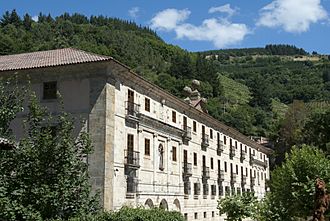San Juan Bautista de Corias facts for kids
Quick facts for kids Abbey of San Juan Bautista de Corias |
|
|---|---|
|
Monasterio de San Juan Bautista de Corias
|
|
 |
|
| Alternative names | Parador de Corias |
| Hotel chain | Paradores |
| General information | |
| Location | Cangas del Narcea (Asturias), Spain |
| Type | Non-movable |
| Criteria | Monument |
| Designated | 24 July 1982 |
| Reference no. | RI-51-0004672 |
The Abbey of San Juan Bautista de Corias (which means "Saint John the Baptist Abbey of Corias") is an old Benedictine monastery in Corias, Spain. It's located in Cangas del Narcea, Asturias, right by the Narcea River. This special place was built to honor Saint John the Baptist. Today, many people call it "the Asturian Escorial." This is because King Bermudo I of Asturias (who died in 797) and his family were buried there. It's a very important historical site in the region.
Contents
History of the Abbey
How the Abbey Started
The abbey began in the year 1022. A rich couple, Count Piñolo Jiménez and his wife Aldonza Muñoz, gave land for it. They were important people from the Kingdom of León.
The building of the monastery started soon after. It was built in the Romanesque style, which was popular at the time. The main construction finished in 1043. A group of monks then moved in the next year.
Early Leaders and Challenges
The first leader of the abbey was Abbot Arias Cromaz. He was related to the family who donated the land. After 19 years, he became the Bishop of Oviedo.
In its early days, the abbey had some disagreements. These were often about land with other powerful people nearby. Around the year 1100, the abbey made deals with Count Fernando Díaz. They traded towns to settle these land issues.
Golden Age and Influence
The abbey became very powerful in the 1100s and 1200s. It owned land all across western Asturias and even into the Province of León.
The monks helped the region grow a lot. They taught people how to grow grapes for wine. They also introduced crops like cereals and tobacco to Asturias. The monks also improved how people raised cattle. They set up pastures in the higher areas. Over time, they also found better ways to hunt and fish on their lands.
Fire and Rebuilding
The monastery was changed and added to over many years. But in 1763, a big fire destroyed most of the building. Only the church and its sacristy, built in the 1500s, survived.
The abbey was rebuilt in a new style called Neoclassical. The first plans were made by Lucas Ferro Caaveiro. He was a famous architect from Galicia. He died in 1770, so Ventura Rodríguez took over in 1774. The new building had a rectangular shape with two courtyards. The church was placed in a side wing.
One special item that survived the fire is a crucifix from the 1100s. It is called the "Christ of the Cantonada." People think it's one of the best examples of Romanesque art in Asturias. Sadly, because of the fire, the graves of King Bermudo and his family can no longer be found.
The Abbey Today
Today, the old abbey is a group of buildings. The Spanish government protects it as a Bien de Interés Cultural, which means it's a very important cultural site.
Part of the abbey is now a parador. A parador is a fancy hotel, often in a historic building. It also has an interpretation center. This center helps visitors learn about the nearby natural park.
See also
 In Spanish: Monasterio de San Juan Bautista (Corias) para niños
In Spanish: Monasterio de San Juan Bautista (Corias) para niños

